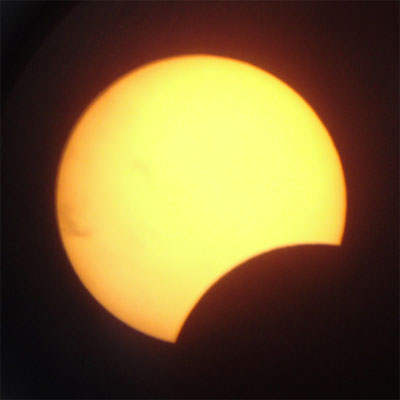Longest solar eclipse of the millennium begins
 New Delhi, Jan 15 : The stage is set for astronomy lovers to witness the longest solar eclipse of the millennium on Friday, as the sun eclipse in India began around 11 a. m. and is expected to finish around 3:15 p. m., with the maximum eclipse to be witnessed at 1:39 p. m.
New Delhi, Jan 15 : The stage is set for astronomy lovers to witness the longest solar eclipse of the millennium on Friday, as the sun eclipse in India began around 11 a. m. and is expected to finish around 3:15 p. m., with the maximum eclipse to be witnessed at 1:39 p. m.
The people of Delhi, Tamil Nadu, Mumbai, Varanasi, Chennai, Kurkshetra and Kerala are witnessing the solar eclipse at present.
The photosphere of the sun would be covered by the moon and form a ring of fire in the sky for more than 10 minutes in some parts of India.
Science Popularisation Association of Communicators and Educators (SPACE), C B Devgun said, "The solar eclipse on January 15 is the longest annular solar eclipse that will occur in the 21st century."
C B Devgun further said, "A solar eclipse takes place when the moon passes between the Earth and the Sun, thereby totally or partially obscuring the Earth''s view of the Sun."
"While an annular eclipse occurs when the Moon is farther from the Earth than normal, and hence its apparent size is not quite sufficient to cover the Sun completely, he added.
In annular solar eclipse, the Sun appears as a very bright annulus, which in Latin means ''ring'', surrounding the outline of the Moon, giving the appearance of a ''Ring of Fire'', said Devgun in addition.
Devgun said that the path of annularity in India would pass over the states of Kerala, Tamil Nadu and Mizoram, while the partial phase of eclipse would be visible all over the country.
Indian Institute Of Astrophysics Professor R C Kapoor said, "Apart from India, the annular eclipse will be visible across Africa, the Indian Ocean, Maldives, Sri Lanka, and south-east Asia."
"The annular phase will begin at 05:13:54 UT (Universal Time) in the Central African Republic and ends on the Chinese Yellow Sea coast at 08:59:01 UT," added Kapoor.
In Delhi, the annual eclipse is expected to start at 11:53 a. m. and end at 15:11 p. m., with a maximum at 1:53 p. m.
The north tip of the path of annularity will touch India first at 8.801 N longitude, 76.656 E latitude, about 10 km south of Kollam and about 2 km south west of a nearby place Paravur in Kerala. Vedaranyam in Tamil Nadu will witness the last touch of the annular solar eclipse.
Nehru Planetarium Director Rathnasree said that only properly designed and certified solar filters or goggles should be used to view the annular solar eclipse.
"The safest way to view the Sun''s disk is by indirect projection using pinhole cameras, created by projecting an image of the disk onto a white piece of paper or card using a pair of binoculars
(with one of the lenses covered), a telescope, or another piece of cardboard with a small hole in it (about 1 mm diameter)," he added.
Ophthalmologists have warned against looking at the sun directly as it could cause damage to the retina of eye. (ANI)